Collin ATM Subsystem Analysis
VerifiedAdded on 2021/04/17
|16
|2259
|84
AI Summary
The provided report is a comprehensive study of the Collin ATM subsystem. It delves into various aspects such as asynchronous transfer mode (ATM), different planes like control, user, and management, and ATM cells. The report also discusses standard support for ATM, including architecture and system-level processes. Furthermore, it touches upon the concept of an ATM being a self-service bank terminal that accepts deposits and withdrawals. The driver/interrupt handle (DIH) is also explained in detail. Overall, the report offers a thorough examination of the Collin ATM subsystem, highlighting its key components and functionalities.
Contribute Materials
Your contribution can guide someone’s learning journey. Share your
documents today.

Running head: OBJECT MODELLING
Object modelling
Assessment 3
[Name of the student]
[Name of the university]
Object modelling
Assessment 3
[Name of the student]
[Name of the university]
Secure Best Marks with AI Grader
Need help grading? Try our AI Grader for instant feedback on your assignments.
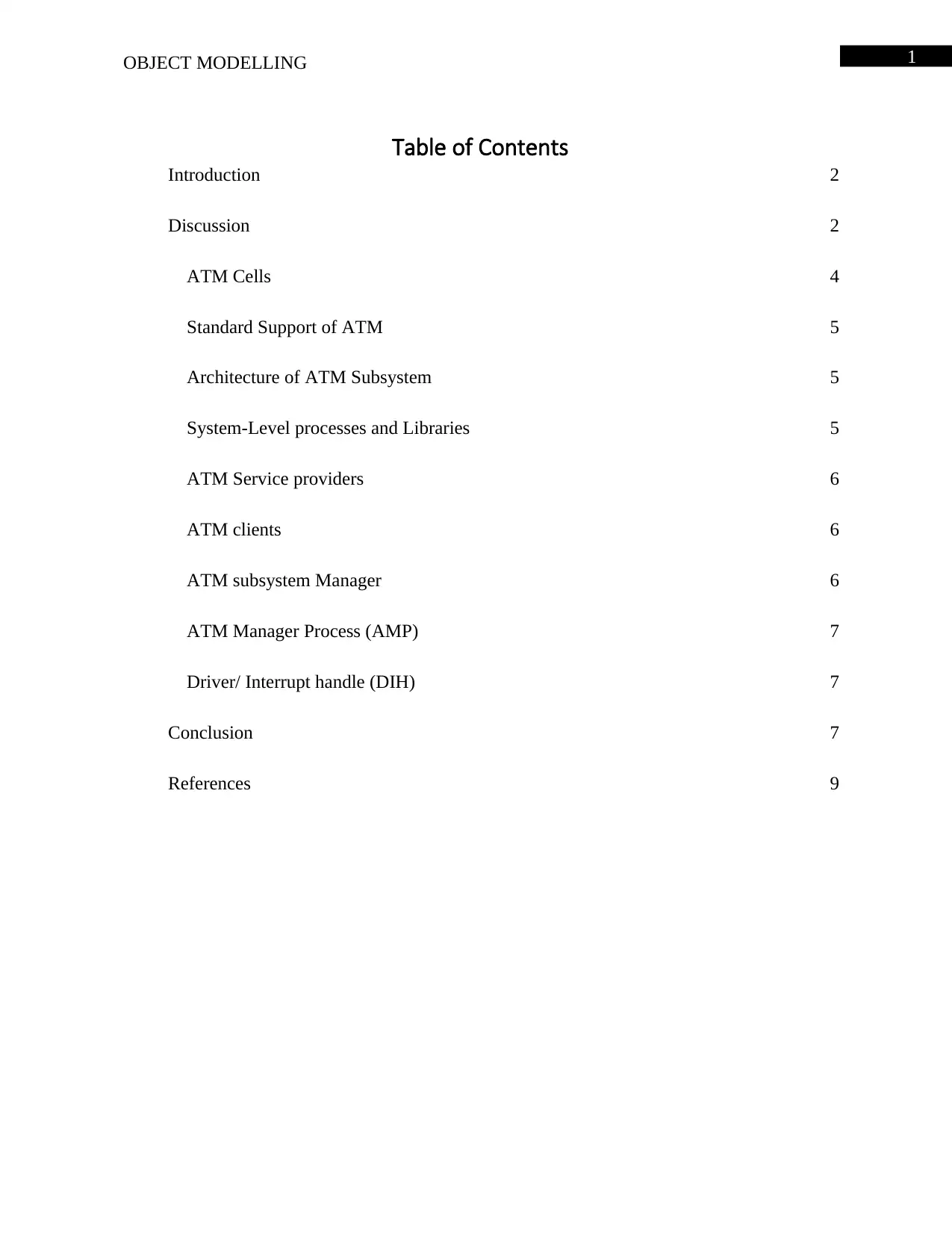
1OBJECT MODELLING
Table of Contents
Introduction 2
Discussion 2
ATM Cells 4
Standard Support of ATM 5
Architecture of ATM Subsystem 5
System-Level processes and Libraries 5
ATM Service providers 6
ATM clients 6
ATM subsystem Manager 6
ATM Manager Process (AMP) 7
Driver/ Interrupt handle (DIH) 7
Conclusion 7
References 9
Table of Contents
Introduction 2
Discussion 2
ATM Cells 4
Standard Support of ATM 5
Architecture of ATM Subsystem 5
System-Level processes and Libraries 5
ATM Service providers 6
ATM clients 6
ATM subsystem Manager 6
ATM Manager Process (AMP) 7
Driver/ Interrupt handle (DIH) 7
Conclusion 7
References 9
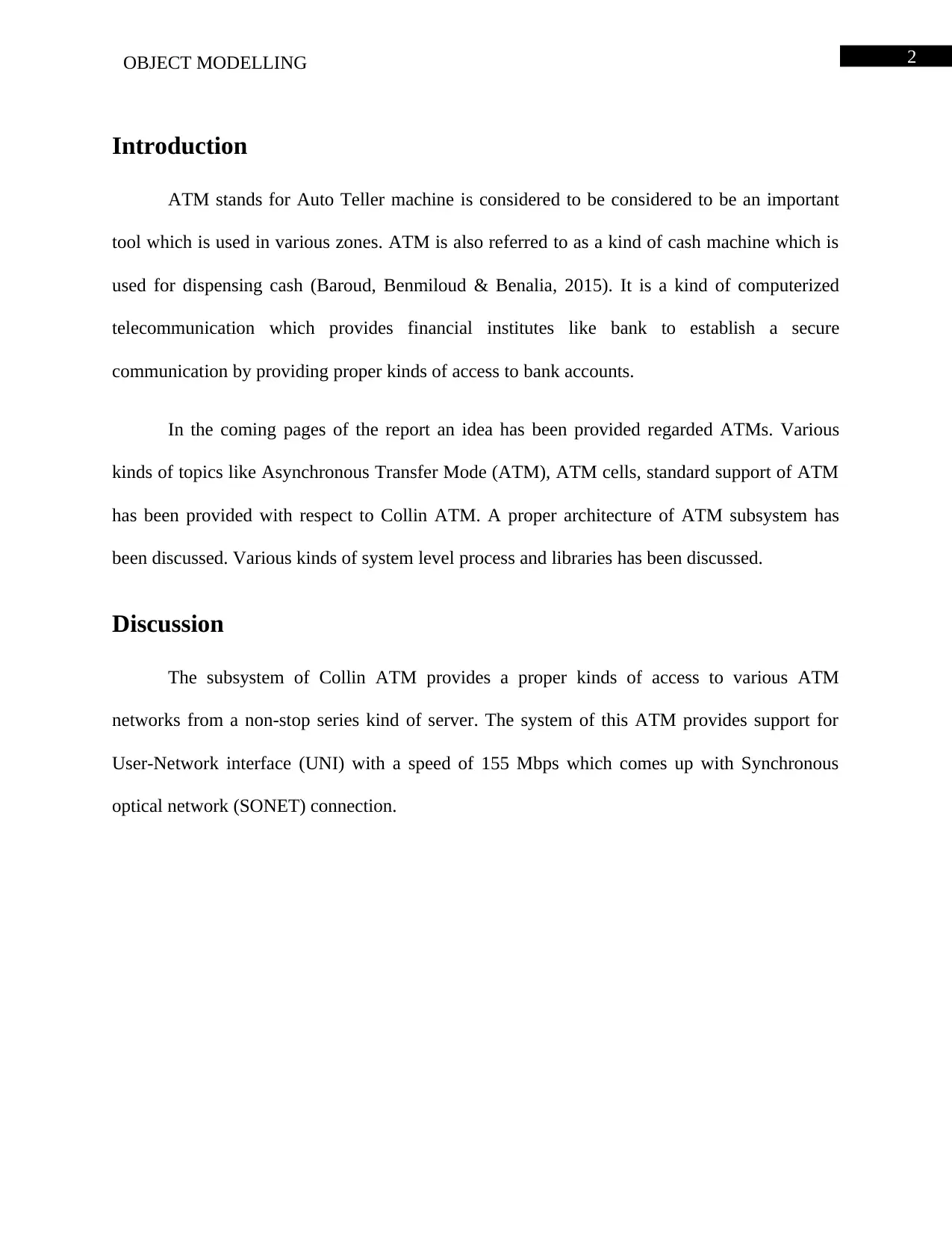
2OBJECT MODELLING
Introduction
ATM stands for Auto Teller machine is considered to be considered to be an important
tool which is used in various zones. ATM is also referred to as a kind of cash machine which is
used for dispensing cash (Baroud, Benmiloud & Benalia, 2015). It is a kind of computerized
telecommunication which provides financial institutes like bank to establish a secure
communication by providing proper kinds of access to bank accounts.
In the coming pages of the report an idea has been provided regarded ATMs. Various
kinds of topics like Asynchronous Transfer Mode (ATM), ATM cells, standard support of ATM
has been provided with respect to Collin ATM. A proper architecture of ATM subsystem has
been discussed. Various kinds of system level process and libraries has been discussed.
Discussion
The subsystem of Collin ATM provides a proper kinds of access to various ATM
networks from a non-stop series kind of server. The system of this ATM provides support for
User-Network interface (UNI) with a speed of 155 Mbps which comes up with Synchronous
optical network (SONET) connection.
Introduction
ATM stands for Auto Teller machine is considered to be considered to be an important
tool which is used in various zones. ATM is also referred to as a kind of cash machine which is
used for dispensing cash (Baroud, Benmiloud & Benalia, 2015). It is a kind of computerized
telecommunication which provides financial institutes like bank to establish a secure
communication by providing proper kinds of access to bank accounts.
In the coming pages of the report an idea has been provided regarded ATMs. Various
kinds of topics like Asynchronous Transfer Mode (ATM), ATM cells, standard support of ATM
has been provided with respect to Collin ATM. A proper architecture of ATM subsystem has
been discussed. Various kinds of system level process and libraries has been discussed.
Discussion
The subsystem of Collin ATM provides a proper kinds of access to various ATM
networks from a non-stop series kind of server. The system of this ATM provides support for
User-Network interface (UNI) with a speed of 155 Mbps which comes up with Synchronous
optical network (SONET) connection.
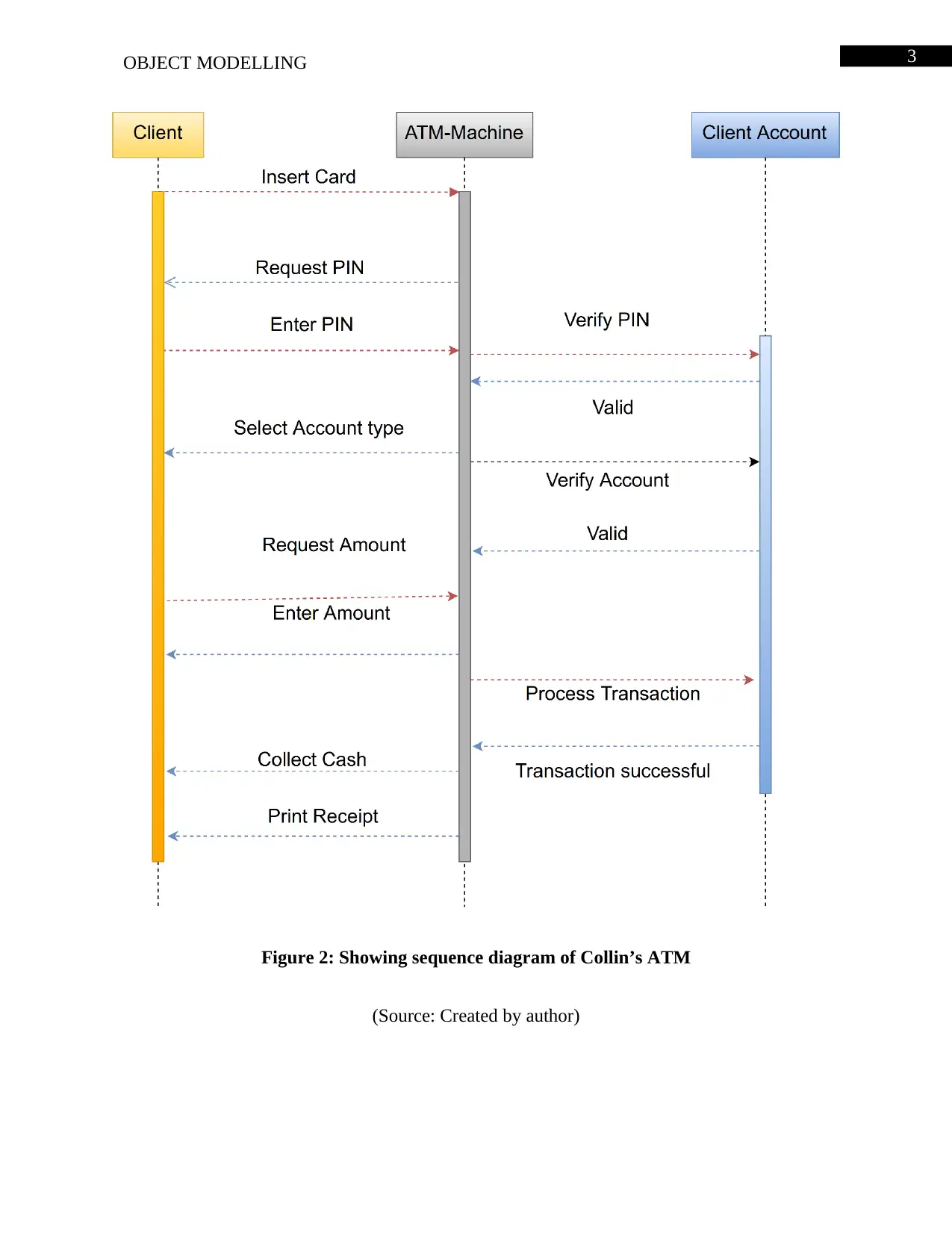
3OBJECT MODELLING
Figure 2: Showing sequence diagram of Collin’s ATM
(Source: Created by author)
Figure 2: Showing sequence diagram of Collin’s ATM
(Source: Created by author)
Secure Best Marks with AI Grader
Need help grading? Try our AI Grader for instant feedback on your assignments.
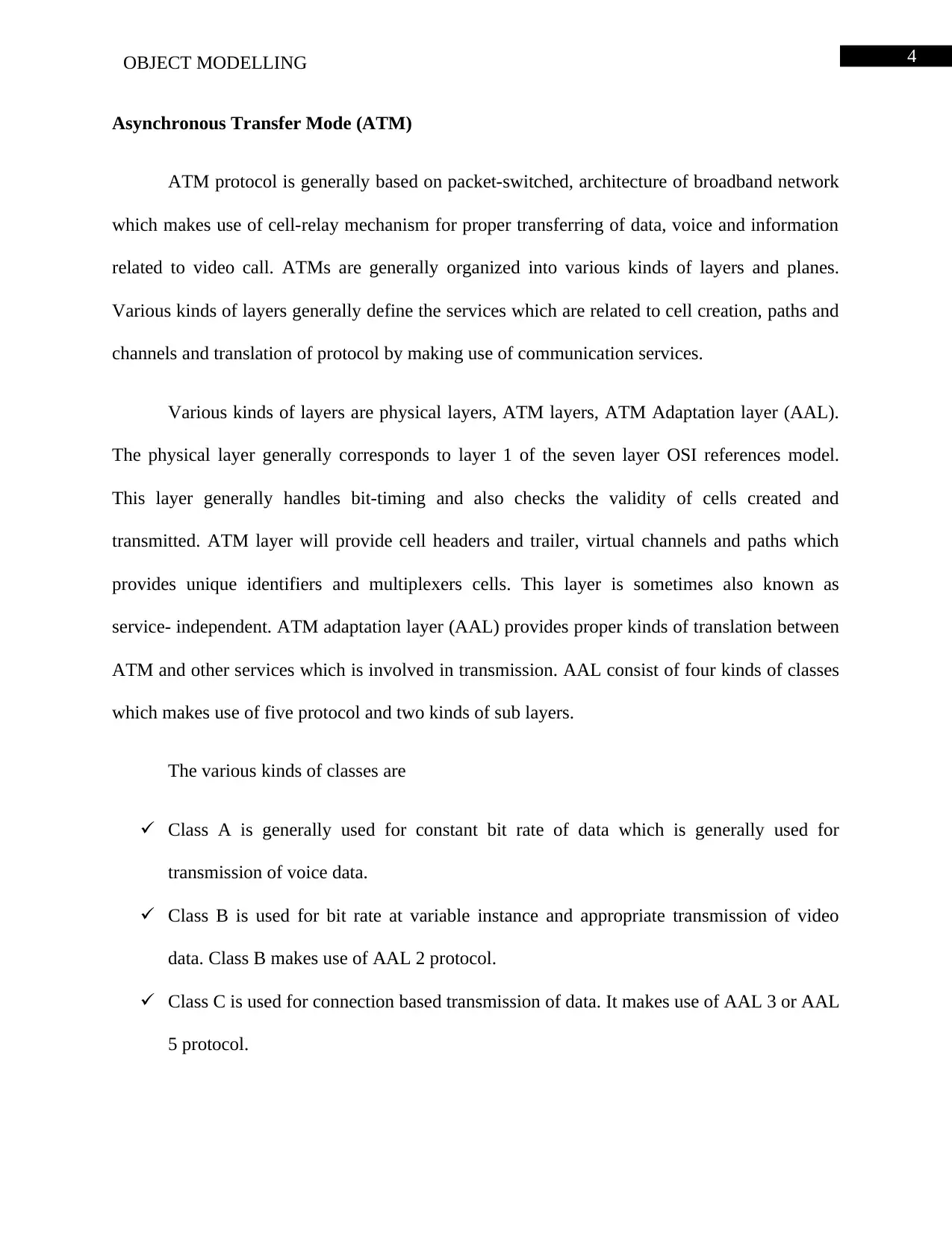
4OBJECT MODELLING
Asynchronous Transfer Mode (ATM)
ATM protocol is generally based on packet-switched, architecture of broadband network
which makes use of cell-relay mechanism for proper transferring of data, voice and information
related to video call. ATMs are generally organized into various kinds of layers and planes.
Various kinds of layers generally define the services which are related to cell creation, paths and
channels and translation of protocol by making use of communication services.
Various kinds of layers are physical layers, ATM layers, ATM Adaptation layer (AAL).
The physical layer generally corresponds to layer 1 of the seven layer OSI references model.
This layer generally handles bit-timing and also checks the validity of cells created and
transmitted. ATM layer will provide cell headers and trailer, virtual channels and paths which
provides unique identifiers and multiplexers cells. This layer is sometimes also known as
service- independent. ATM adaptation layer (AAL) provides proper kinds of translation between
ATM and other services which is involved in transmission. AAL consist of four kinds of classes
which makes use of five protocol and two kinds of sub layers.
The various kinds of classes are
Class A is generally used for constant bit rate of data which is generally used for
transmission of voice data.
Class B is used for bit rate at variable instance and appropriate transmission of video
data. Class B makes use of AAL 2 protocol.
Class C is used for connection based transmission of data. It makes use of AAL 3 or AAL
5 protocol.
Asynchronous Transfer Mode (ATM)
ATM protocol is generally based on packet-switched, architecture of broadband network
which makes use of cell-relay mechanism for proper transferring of data, voice and information
related to video call. ATMs are generally organized into various kinds of layers and planes.
Various kinds of layers generally define the services which are related to cell creation, paths and
channels and translation of protocol by making use of communication services.
Various kinds of layers are physical layers, ATM layers, ATM Adaptation layer (AAL).
The physical layer generally corresponds to layer 1 of the seven layer OSI references model.
This layer generally handles bit-timing and also checks the validity of cells created and
transmitted. ATM layer will provide cell headers and trailer, virtual channels and paths which
provides unique identifiers and multiplexers cells. This layer is sometimes also known as
service- independent. ATM adaptation layer (AAL) provides proper kinds of translation between
ATM and other services which is involved in transmission. AAL consist of four kinds of classes
which makes use of five protocol and two kinds of sub layers.
The various kinds of classes are
Class A is generally used for constant bit rate of data which is generally used for
transmission of voice data.
Class B is used for bit rate at variable instance and appropriate transmission of video
data. Class B makes use of AAL 2 protocol.
Class C is used for connection based transmission of data. It makes use of AAL 3 or AAL
5 protocol.
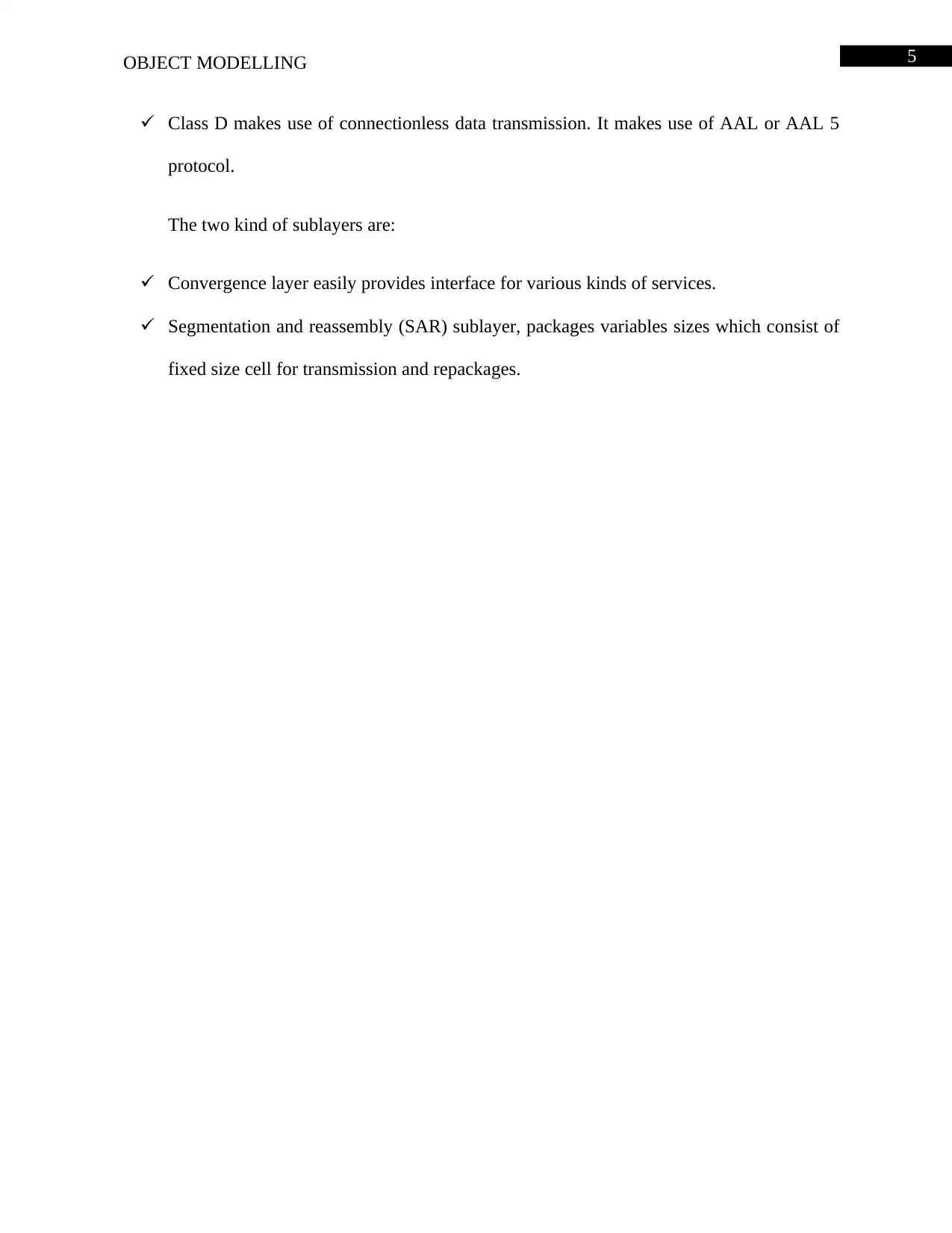
5OBJECT MODELLING
Class D makes use of connectionless data transmission. It makes use of AAL or AAL 5
protocol.
The two kind of sublayers are:
Convergence layer easily provides interface for various kinds of services.
Segmentation and reassembly (SAR) sublayer, packages variables sizes which consist of
fixed size cell for transmission and repackages.
Class D makes use of connectionless data transmission. It makes use of AAL or AAL 5
protocol.
The two kind of sublayers are:
Convergence layer easily provides interface for various kinds of services.
Segmentation and reassembly (SAR) sublayer, packages variables sizes which consist of
fixed size cell for transmission and repackages.
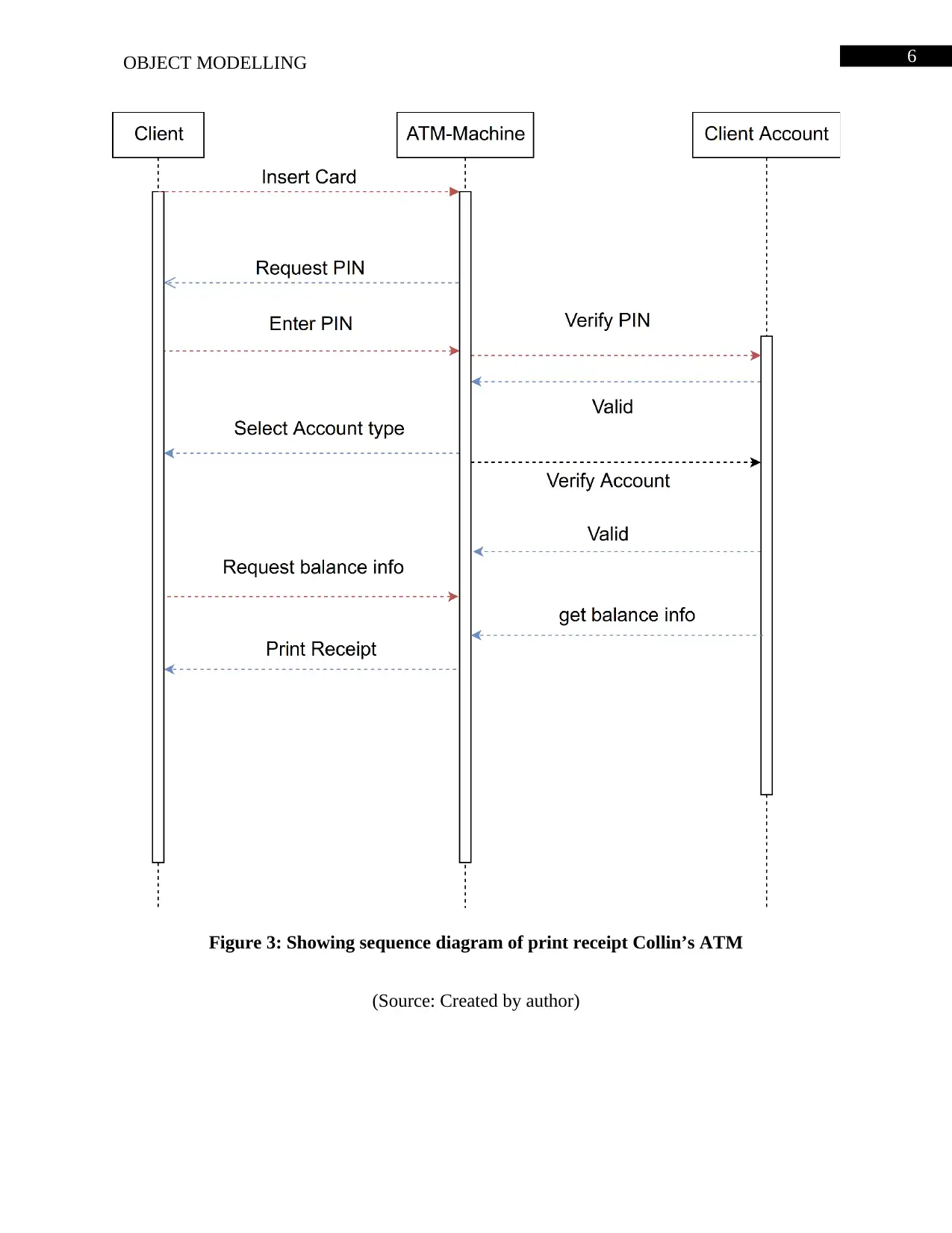
6OBJECT MODELLING
Figure 3: Showing sequence diagram of print receipt Collin’s ATM
(Source: Created by author)
Figure 3: Showing sequence diagram of print receipt Collin’s ATM
(Source: Created by author)
Paraphrase This Document
Need a fresh take? Get an instant paraphrase of this document with our AI Paraphraser
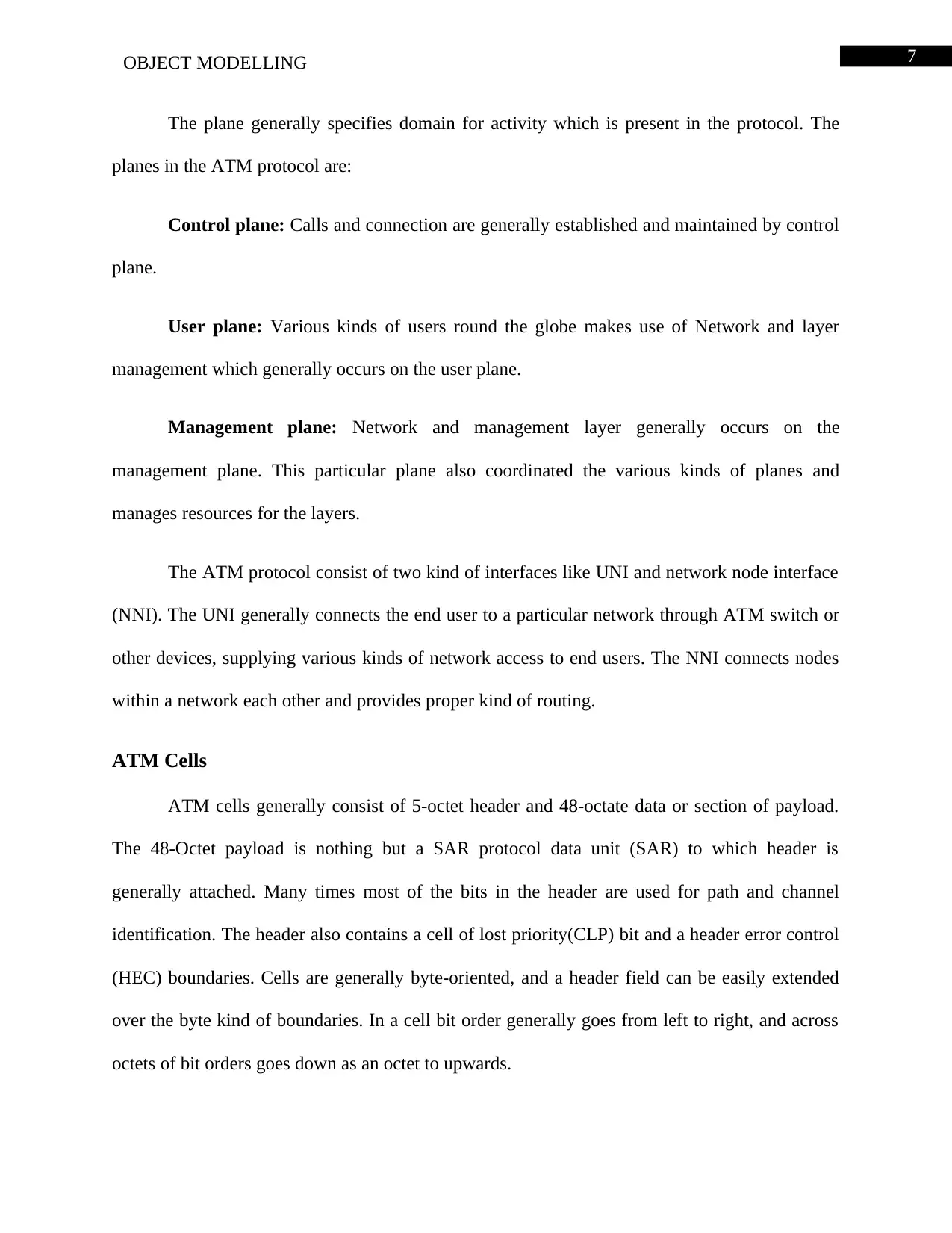
7OBJECT MODELLING
The plane generally specifies domain for activity which is present in the protocol. The
planes in the ATM protocol are:
Control plane: Calls and connection are generally established and maintained by control
plane.
User plane: Various kinds of users round the globe makes use of Network and layer
management which generally occurs on the user plane.
Management plane: Network and management layer generally occurs on the
management plane. This particular plane also coordinated the various kinds of planes and
manages resources for the layers.
The ATM protocol consist of two kind of interfaces like UNI and network node interface
(NNI). The UNI generally connects the end user to a particular network through ATM switch or
other devices, supplying various kinds of network access to end users. The NNI connects nodes
within a network each other and provides proper kind of routing.
ATM Cells
ATM cells generally consist of 5-octet header and 48-octate data or section of payload.
The 48-Octet payload is nothing but a SAR protocol data unit (SAR) to which header is
generally attached. Many times most of the bits in the header are used for path and channel
identification. The header also contains a cell of lost priority(CLP) bit and a header error control
(HEC) boundaries. Cells are generally byte-oriented, and a header field can be easily extended
over the byte kind of boundaries. In a cell bit order generally goes from left to right, and across
octets of bit orders goes down as an octet to upwards.
The plane generally specifies domain for activity which is present in the protocol. The
planes in the ATM protocol are:
Control plane: Calls and connection are generally established and maintained by control
plane.
User plane: Various kinds of users round the globe makes use of Network and layer
management which generally occurs on the user plane.
Management plane: Network and management layer generally occurs on the
management plane. This particular plane also coordinated the various kinds of planes and
manages resources for the layers.
The ATM protocol consist of two kind of interfaces like UNI and network node interface
(NNI). The UNI generally connects the end user to a particular network through ATM switch or
other devices, supplying various kinds of network access to end users. The NNI connects nodes
within a network each other and provides proper kind of routing.
ATM Cells
ATM cells generally consist of 5-octet header and 48-octate data or section of payload.
The 48-Octet payload is nothing but a SAR protocol data unit (SAR) to which header is
generally attached. Many times most of the bits in the header are used for path and channel
identification. The header also contains a cell of lost priority(CLP) bit and a header error control
(HEC) boundaries. Cells are generally byte-oriented, and a header field can be easily extended
over the byte kind of boundaries. In a cell bit order generally goes from left to right, and across
octets of bit orders goes down as an octet to upwards.
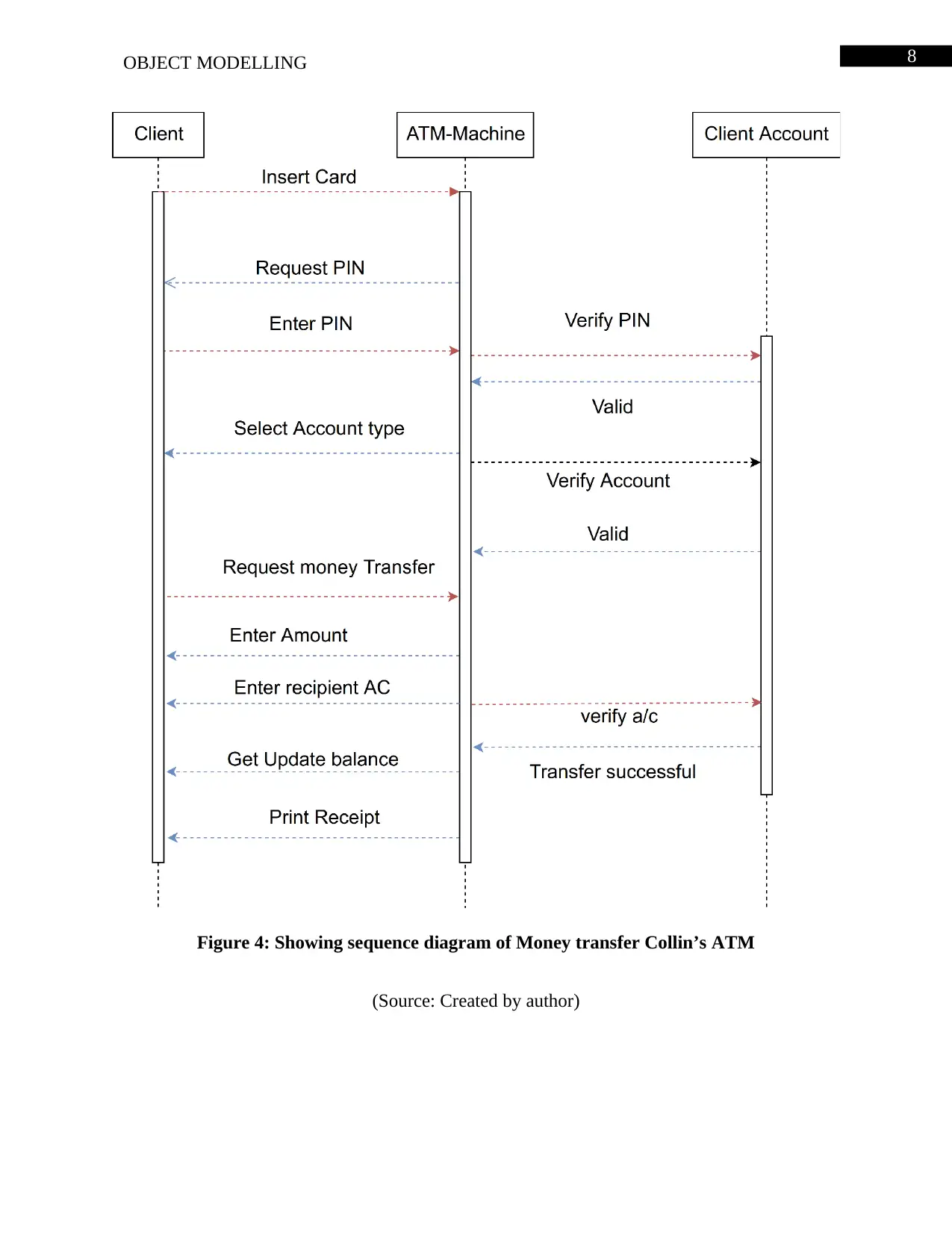
8OBJECT MODELLING
Figure 4: Showing sequence diagram of Money transfer Collin’s ATM
(Source: Created by author)
Figure 4: Showing sequence diagram of Money transfer Collin’s ATM
(Source: Created by author)
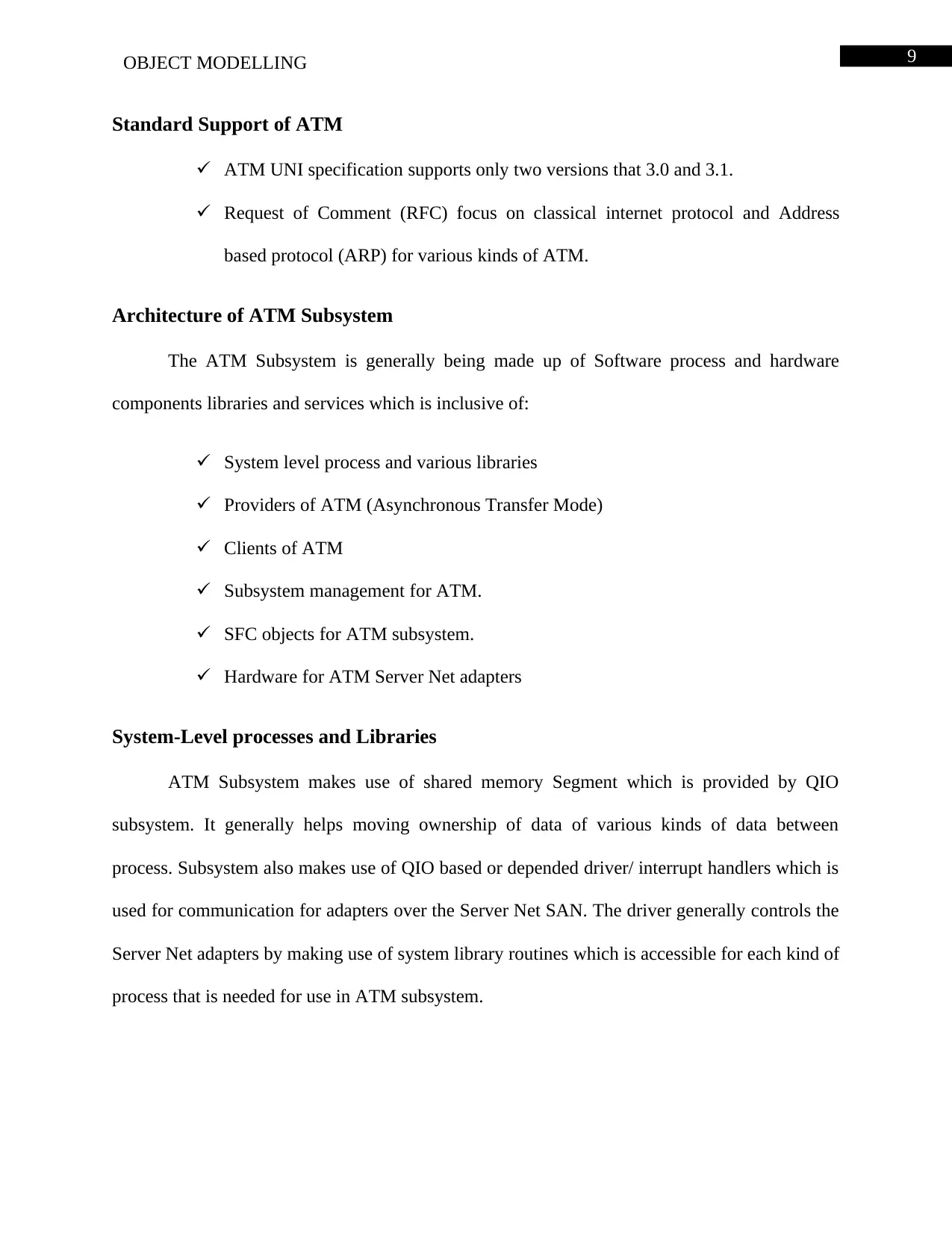
9OBJECT MODELLING
Standard Support of ATM
ATM UNI specification supports only two versions that 3.0 and 3.1.
Request of Comment (RFC) focus on classical internet protocol and Address
based protocol (ARP) for various kinds of ATM.
Architecture of ATM Subsystem
The ATM Subsystem is generally being made up of Software process and hardware
components libraries and services which is inclusive of:
System level process and various libraries
Providers of ATM (Asynchronous Transfer Mode)
Clients of ATM
Subsystem management for ATM.
SFC objects for ATM subsystem.
Hardware for ATM Server Net adapters
System-Level processes and Libraries
ATM Subsystem makes use of shared memory Segment which is provided by QIO
subsystem. It generally helps moving ownership of data of various kinds of data between
process. Subsystem also makes use of QIO based or depended driver/ interrupt handlers which is
used for communication for adapters over the Server Net SAN. The driver generally controls the
Server Net adapters by making use of system library routines which is accessible for each kind of
process that is needed for use in ATM subsystem.
Standard Support of ATM
ATM UNI specification supports only two versions that 3.0 and 3.1.
Request of Comment (RFC) focus on classical internet protocol and Address
based protocol (ARP) for various kinds of ATM.
Architecture of ATM Subsystem
The ATM Subsystem is generally being made up of Software process and hardware
components libraries and services which is inclusive of:
System level process and various libraries
Providers of ATM (Asynchronous Transfer Mode)
Clients of ATM
Subsystem management for ATM.
SFC objects for ATM subsystem.
Hardware for ATM Server Net adapters
System-Level processes and Libraries
ATM Subsystem makes use of shared memory Segment which is provided by QIO
subsystem. It generally helps moving ownership of data of various kinds of data between
process. Subsystem also makes use of QIO based or depended driver/ interrupt handlers which is
used for communication for adapters over the Server Net SAN. The driver generally controls the
Server Net adapters by making use of system library routines which is accessible for each kind of
process that is needed for use in ATM subsystem.
Secure Best Marks with AI Grader
Need help grading? Try our AI Grader for instant feedback on your assignments.
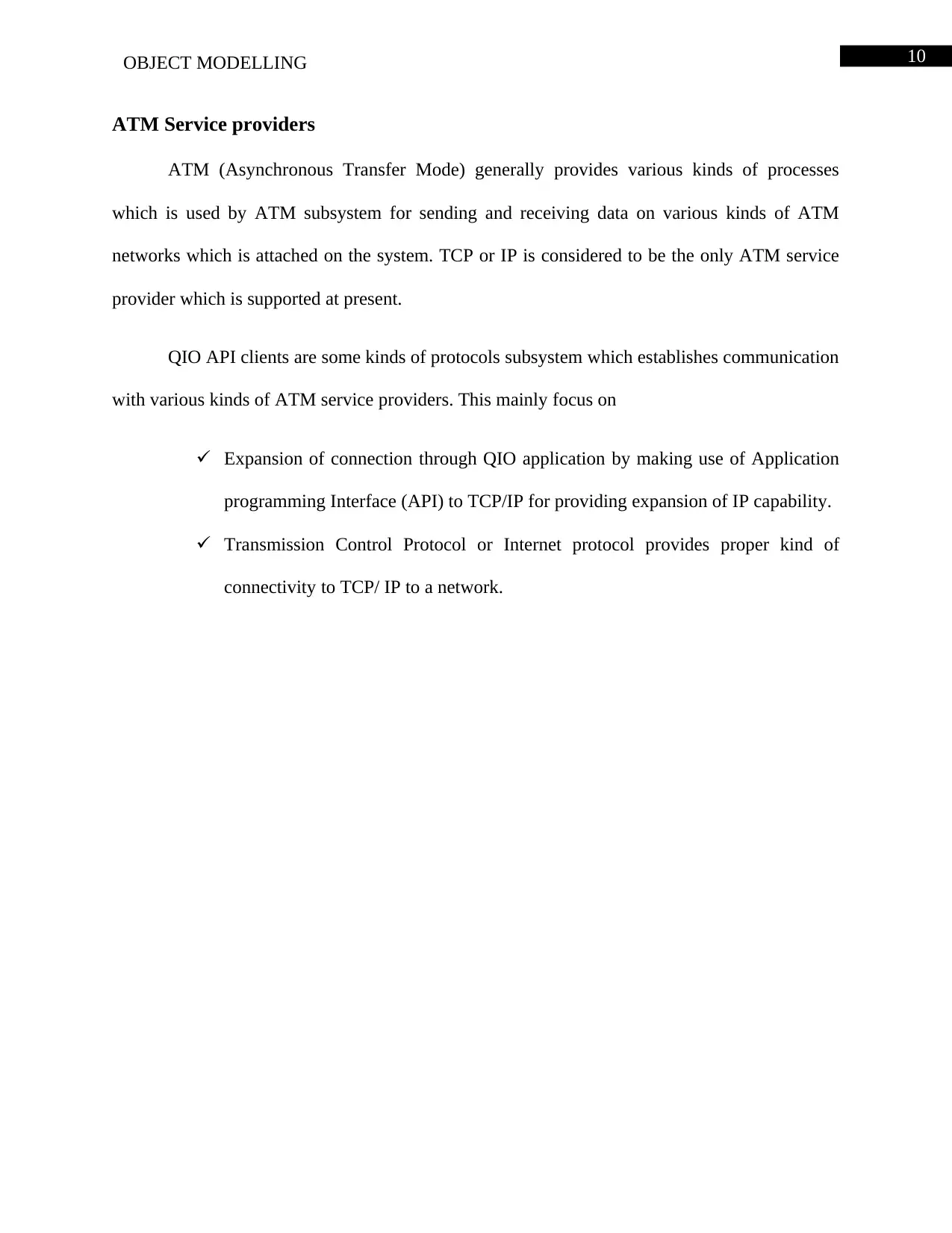
10OBJECT MODELLING
ATM Service providers
ATM (Asynchronous Transfer Mode) generally provides various kinds of processes
which is used by ATM subsystem for sending and receiving data on various kinds of ATM
networks which is attached on the system. TCP or IP is considered to be the only ATM service
provider which is supported at present.
QIO API clients are some kinds of protocols subsystem which establishes communication
with various kinds of ATM service providers. This mainly focus on
Expansion of connection through QIO application by making use of Application
programming Interface (API) to TCP/IP for providing expansion of IP capability.
Transmission Control Protocol or Internet protocol provides proper kind of
connectivity to TCP/ IP to a network.
ATM Service providers
ATM (Asynchronous Transfer Mode) generally provides various kinds of processes
which is used by ATM subsystem for sending and receiving data on various kinds of ATM
networks which is attached on the system. TCP or IP is considered to be the only ATM service
provider which is supported at present.
QIO API clients are some kinds of protocols subsystem which establishes communication
with various kinds of ATM service providers. This mainly focus on
Expansion of connection through QIO application by making use of Application
programming Interface (API) to TCP/IP for providing expansion of IP capability.
Transmission Control Protocol or Internet protocol provides proper kind of
connectivity to TCP/ IP to a network.
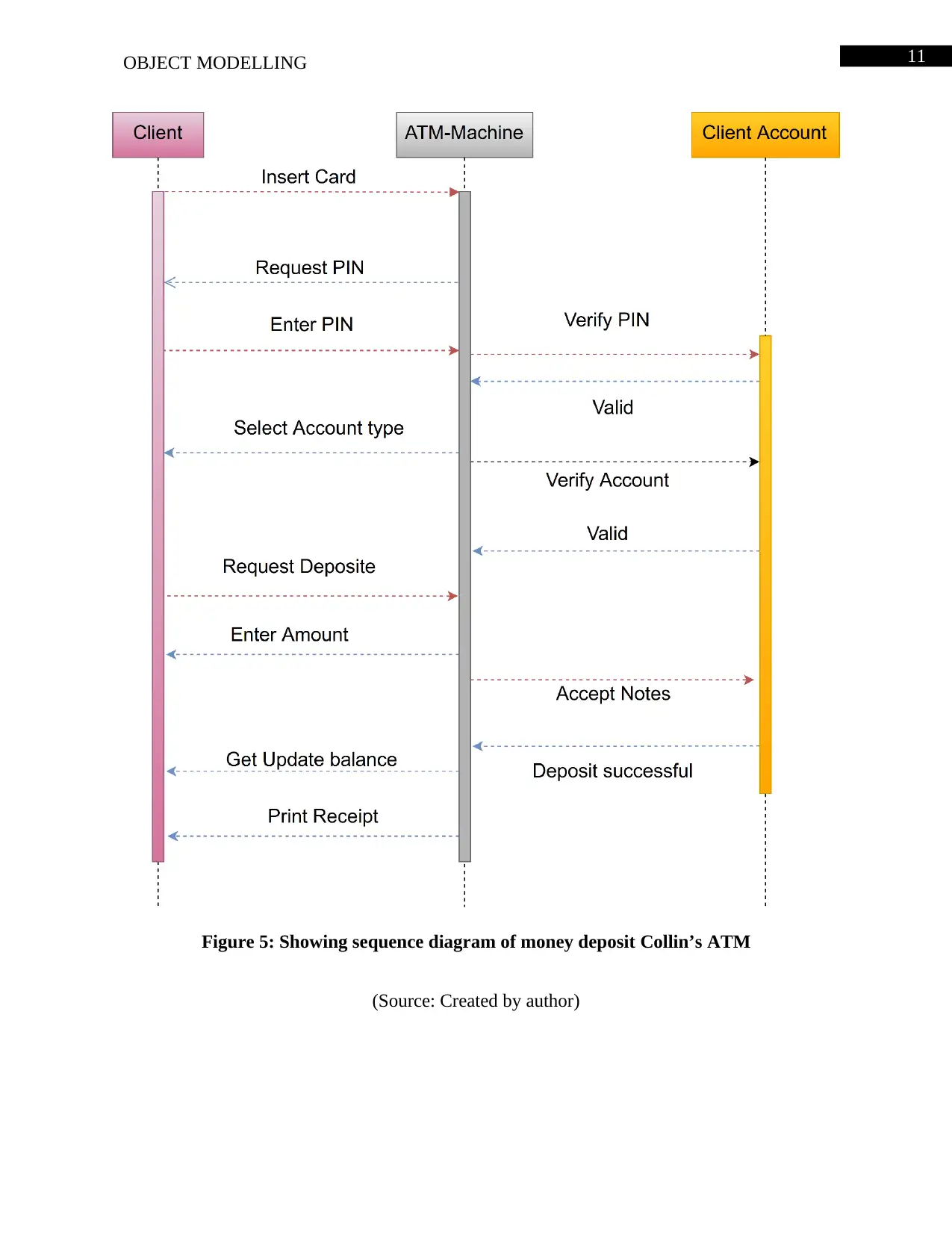
11OBJECT MODELLING
Figure 5: Showing sequence diagram of money deposit Collin’s ATM
(Source: Created by author)
Figure 5: Showing sequence diagram of money deposit Collin’s ATM
(Source: Created by author)
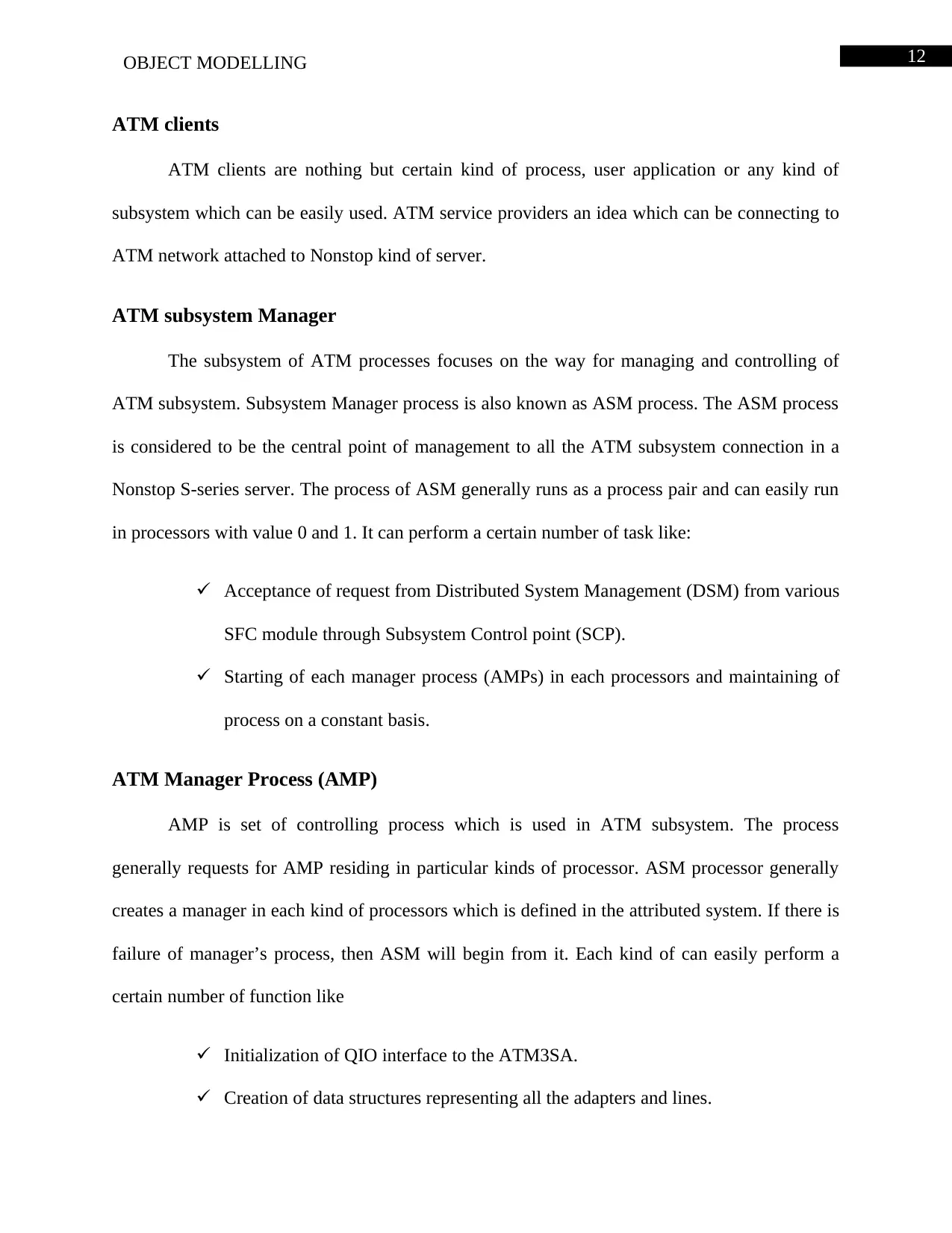
12OBJECT MODELLING
ATM clients
ATM clients are nothing but certain kind of process, user application or any kind of
subsystem which can be easily used. ATM service providers an idea which can be connecting to
ATM network attached to Nonstop kind of server.
ATM subsystem Manager
The subsystem of ATM processes focuses on the way for managing and controlling of
ATM subsystem. Subsystem Manager process is also known as ASM process. The ASM process
is considered to be the central point of management to all the ATM subsystem connection in a
Nonstop S-series server. The process of ASM generally runs as a process pair and can easily run
in processors with value 0 and 1. It can perform a certain number of task like:
Acceptance of request from Distributed System Management (DSM) from various
SFC module through Subsystem Control point (SCP).
Starting of each manager process (AMPs) in each processors and maintaining of
process on a constant basis.
ATM Manager Process (AMP)
AMP is set of controlling process which is used in ATM subsystem. The process
generally requests for AMP residing in particular kinds of processor. ASM processor generally
creates a manager in each kind of processors which is defined in the attributed system. If there is
failure of manager’s process, then ASM will begin from it. Each kind of can easily perform a
certain number of function like
Initialization of QIO interface to the ATM3SA.
Creation of data structures representing all the adapters and lines.
ATM clients
ATM clients are nothing but certain kind of process, user application or any kind of
subsystem which can be easily used. ATM service providers an idea which can be connecting to
ATM network attached to Nonstop kind of server.
ATM subsystem Manager
The subsystem of ATM processes focuses on the way for managing and controlling of
ATM subsystem. Subsystem Manager process is also known as ASM process. The ASM process
is considered to be the central point of management to all the ATM subsystem connection in a
Nonstop S-series server. The process of ASM generally runs as a process pair and can easily run
in processors with value 0 and 1. It can perform a certain number of task like:
Acceptance of request from Distributed System Management (DSM) from various
SFC module through Subsystem Control point (SCP).
Starting of each manager process (AMPs) in each processors and maintaining of
process on a constant basis.
ATM Manager Process (AMP)
AMP is set of controlling process which is used in ATM subsystem. The process
generally requests for AMP residing in particular kinds of processor. ASM processor generally
creates a manager in each kind of processors which is defined in the attributed system. If there is
failure of manager’s process, then ASM will begin from it. Each kind of can easily perform a
certain number of function like
Initialization of QIO interface to the ATM3SA.
Creation of data structures representing all the adapters and lines.
Paraphrase This Document
Need a fresh take? Get an instant paraphrase of this document with our AI Paraphraser
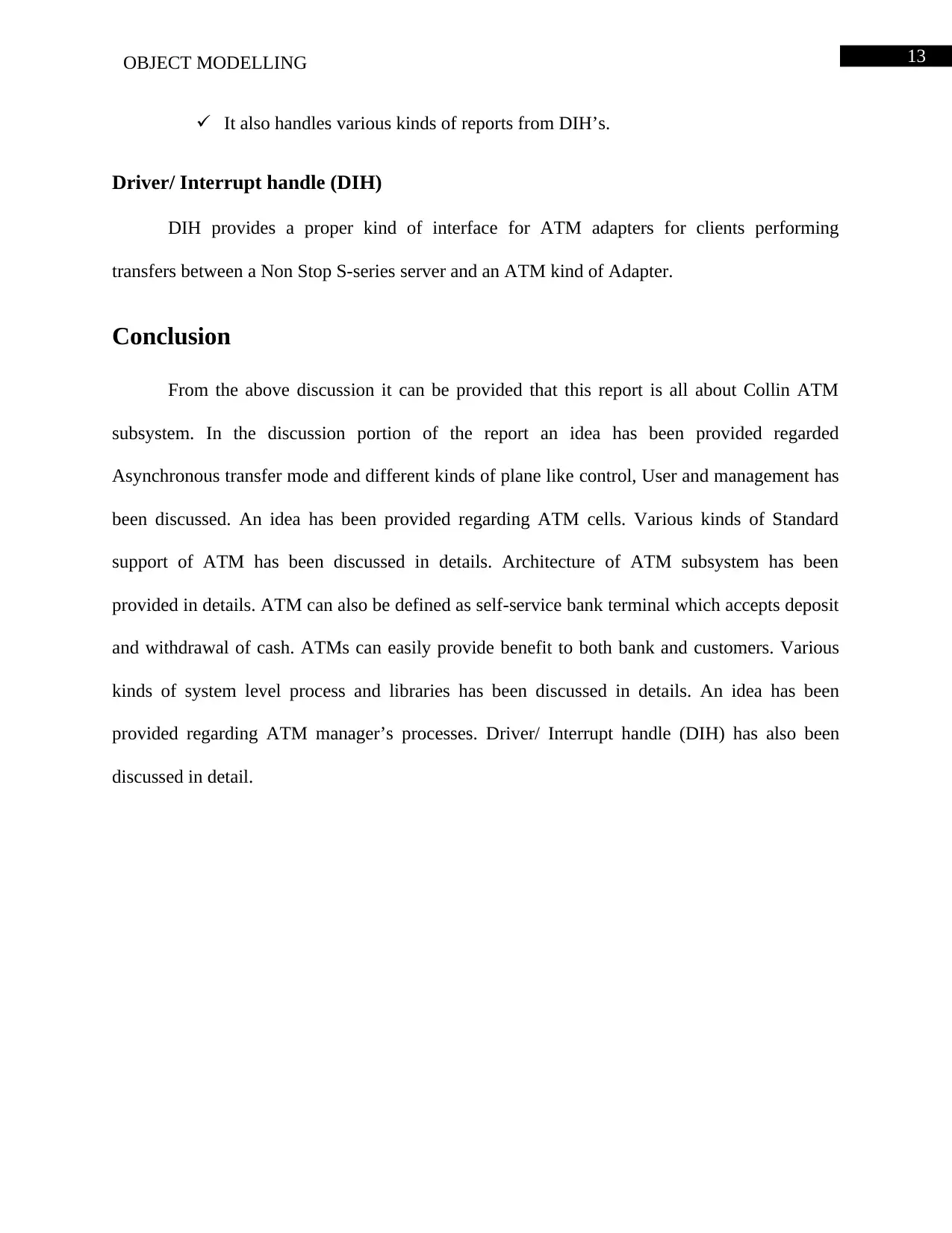
13OBJECT MODELLING
It also handles various kinds of reports from DIH’s.
Driver/ Interrupt handle (DIH)
DIH provides a proper kind of interface for ATM adapters for clients performing
transfers between a Non Stop S-series server and an ATM kind of Adapter.
Conclusion
From the above discussion it can be provided that this report is all about Collin ATM
subsystem. In the discussion portion of the report an idea has been provided regarded
Asynchronous transfer mode and different kinds of plane like control, User and management has
been discussed. An idea has been provided regarding ATM cells. Various kinds of Standard
support of ATM has been discussed in details. Architecture of ATM subsystem has been
provided in details. ATM can also be defined as self-service bank terminal which accepts deposit
and withdrawal of cash. ATMs can easily provide benefit to both bank and customers. Various
kinds of system level process and libraries has been discussed in details. An idea has been
provided regarding ATM manager’s processes. Driver/ Interrupt handle (DIH) has also been
discussed in detail.
It also handles various kinds of reports from DIH’s.
Driver/ Interrupt handle (DIH)
DIH provides a proper kind of interface for ATM adapters for clients performing
transfers between a Non Stop S-series server and an ATM kind of Adapter.
Conclusion
From the above discussion it can be provided that this report is all about Collin ATM
subsystem. In the discussion portion of the report an idea has been provided regarded
Asynchronous transfer mode and different kinds of plane like control, User and management has
been discussed. An idea has been provided regarding ATM cells. Various kinds of Standard
support of ATM has been discussed in details. Architecture of ATM subsystem has been
provided in details. ATM can also be defined as self-service bank terminal which accepts deposit
and withdrawal of cash. ATMs can easily provide benefit to both bank and customers. Various
kinds of system level process and libraries has been discussed in details. An idea has been
provided regarding ATM manager’s processes. Driver/ Interrupt handle (DIH) has also been
discussed in detail.
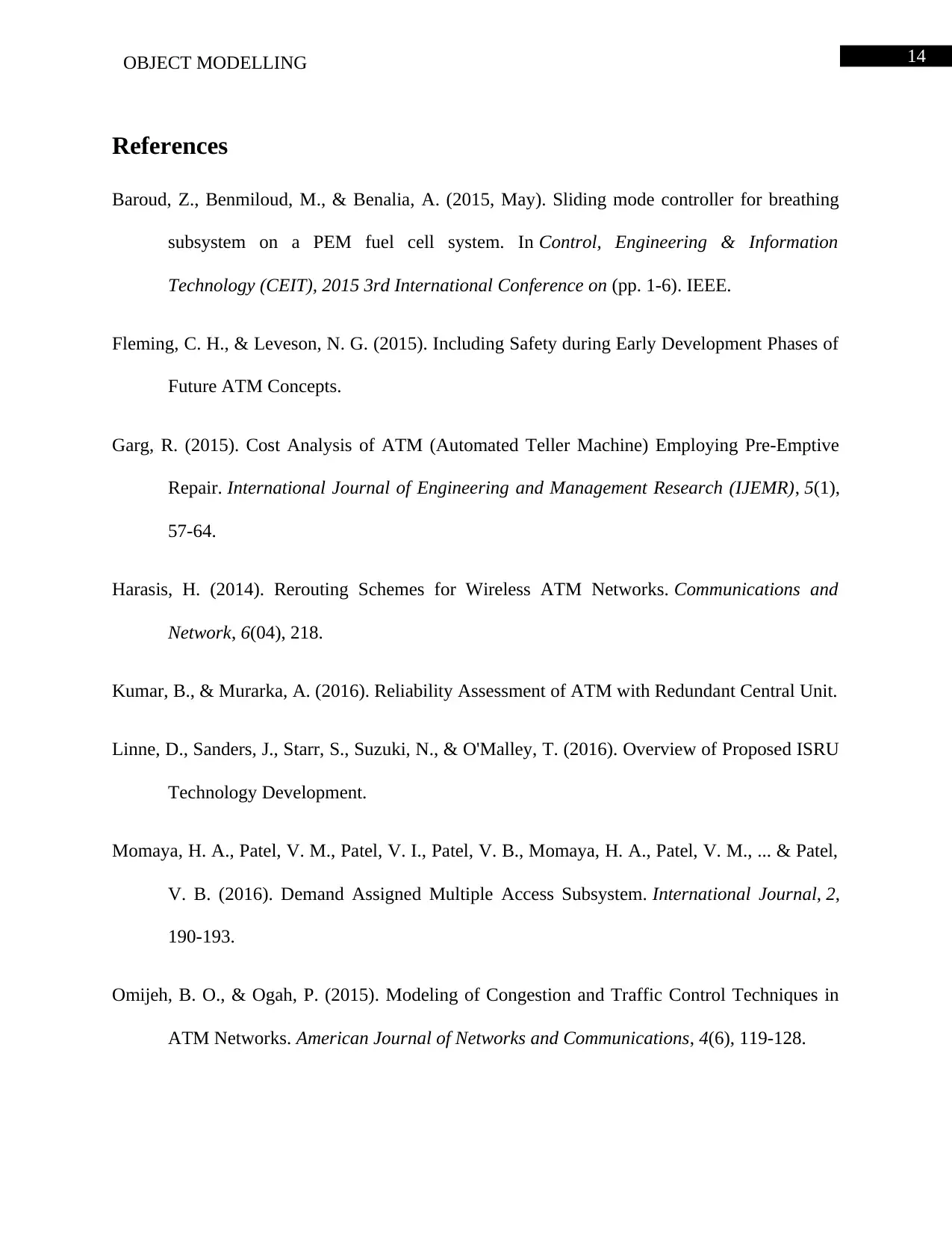
14OBJECT MODELLING
References
Baroud, Z., Benmiloud, M., & Benalia, A. (2015, May). Sliding mode controller for breathing
subsystem on a PEM fuel cell system. In Control, Engineering & Information
Technology (CEIT), 2015 3rd International Conference on (pp. 1-6). IEEE.
Fleming, C. H., & Leveson, N. G. (2015). Including Safety during Early Development Phases of
Future ATM Concepts.
Garg, R. (2015). Cost Analysis of ATM (Automated Teller Machine) Employing Pre-Emptive
Repair. International Journal of Engineering and Management Research (IJEMR), 5(1),
57-64.
Harasis, H. (2014). Rerouting Schemes for Wireless ATM Networks. Communications and
Network, 6(04), 218.
Kumar, B., & Murarka, A. (2016). Reliability Assessment of ATM with Redundant Central Unit.
Linne, D., Sanders, J., Starr, S., Suzuki, N., & O'Malley, T. (2016). Overview of Proposed ISRU
Technology Development.
Momaya, H. A., Patel, V. M., Patel, V. I., Patel, V. B., Momaya, H. A., Patel, V. M., ... & Patel,
V. B. (2016). Demand Assigned Multiple Access Subsystem. International Journal, 2,
190-193.
Omijeh, B. O., & Ogah, P. (2015). Modeling of Congestion and Traffic Control Techniques in
ATM Networks. American Journal of Networks and Communications, 4(6), 119-128.
References
Baroud, Z., Benmiloud, M., & Benalia, A. (2015, May). Sliding mode controller for breathing
subsystem on a PEM fuel cell system. In Control, Engineering & Information
Technology (CEIT), 2015 3rd International Conference on (pp. 1-6). IEEE.
Fleming, C. H., & Leveson, N. G. (2015). Including Safety during Early Development Phases of
Future ATM Concepts.
Garg, R. (2015). Cost Analysis of ATM (Automated Teller Machine) Employing Pre-Emptive
Repair. International Journal of Engineering and Management Research (IJEMR), 5(1),
57-64.
Harasis, H. (2014). Rerouting Schemes for Wireless ATM Networks. Communications and
Network, 6(04), 218.
Kumar, B., & Murarka, A. (2016). Reliability Assessment of ATM with Redundant Central Unit.
Linne, D., Sanders, J., Starr, S., Suzuki, N., & O'Malley, T. (2016). Overview of Proposed ISRU
Technology Development.
Momaya, H. A., Patel, V. M., Patel, V. I., Patel, V. B., Momaya, H. A., Patel, V. M., ... & Patel,
V. B. (2016). Demand Assigned Multiple Access Subsystem. International Journal, 2,
190-193.
Omijeh, B. O., & Ogah, P. (2015). Modeling of Congestion and Traffic Control Techniques in
ATM Networks. American Journal of Networks and Communications, 4(6), 119-128.
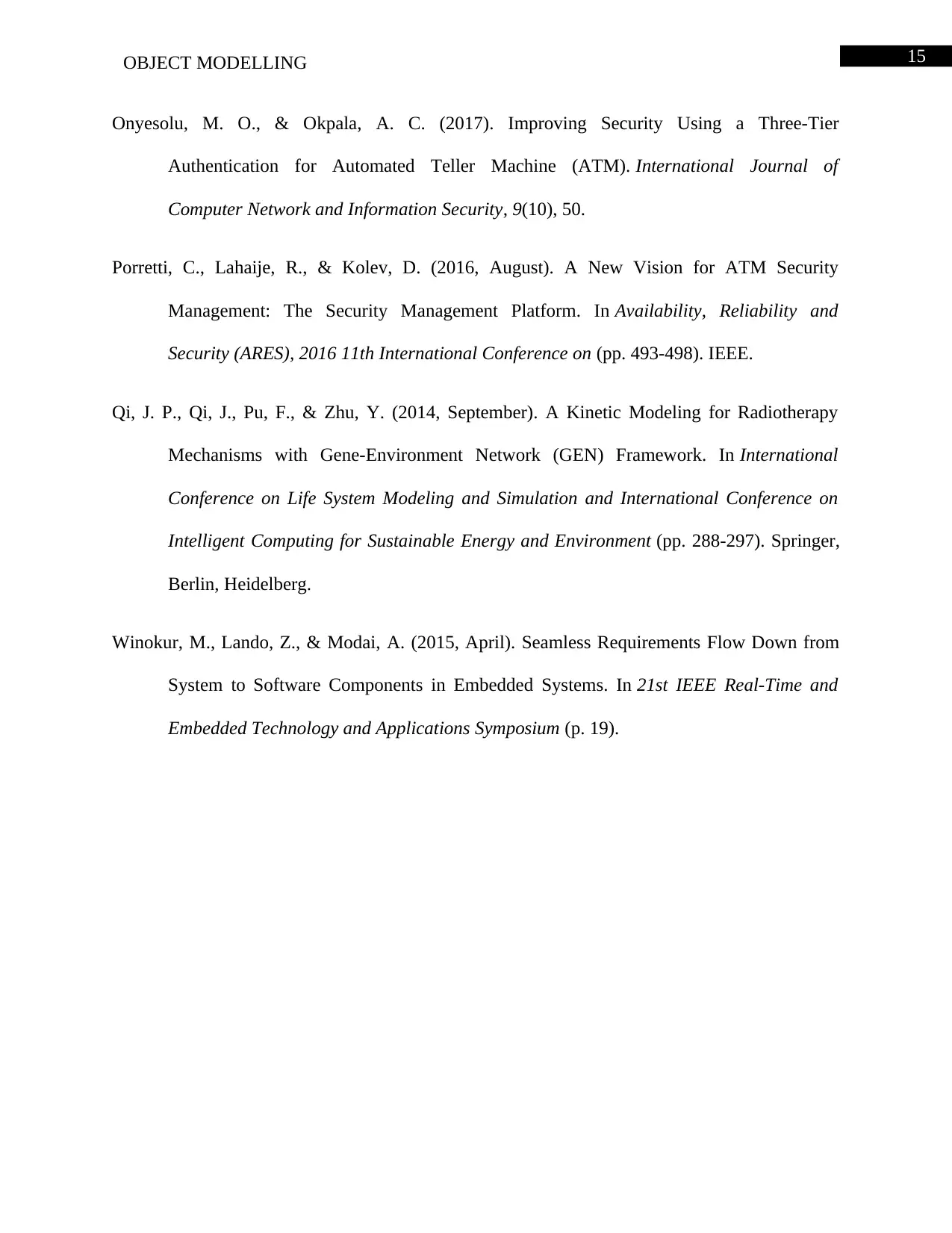
15OBJECT MODELLING
Onyesolu, M. O., & Okpala, A. C. (2017). Improving Security Using a Three-Tier
Authentication for Automated Teller Machine (ATM). International Journal of
Computer Network and Information Security, 9(10), 50.
Porretti, C., Lahaije, R., & Kolev, D. (2016, August). A New Vision for ATM Security
Management: The Security Management Platform. In Availability, Reliability and
Security (ARES), 2016 11th International Conference on (pp. 493-498). IEEE.
Qi, J. P., Qi, J., Pu, F., & Zhu, Y. (2014, September). A Kinetic Modeling for Radiotherapy
Mechanisms with Gene-Environment Network (GEN) Framework. In International
Conference on Life System Modeling and Simulation and International Conference on
Intelligent Computing for Sustainable Energy and Environment (pp. 288-297). Springer,
Berlin, Heidelberg.
Winokur, M., Lando, Z., & Modai, A. (2015, April). Seamless Requirements Flow Down from
System to Software Components in Embedded Systems. In 21st IEEE Real-Time and
Embedded Technology and Applications Symposium (p. 19).
Onyesolu, M. O., & Okpala, A. C. (2017). Improving Security Using a Three-Tier
Authentication for Automated Teller Machine (ATM). International Journal of
Computer Network and Information Security, 9(10), 50.
Porretti, C., Lahaije, R., & Kolev, D. (2016, August). A New Vision for ATM Security
Management: The Security Management Platform. In Availability, Reliability and
Security (ARES), 2016 11th International Conference on (pp. 493-498). IEEE.
Qi, J. P., Qi, J., Pu, F., & Zhu, Y. (2014, September). A Kinetic Modeling for Radiotherapy
Mechanisms with Gene-Environment Network (GEN) Framework. In International
Conference on Life System Modeling and Simulation and International Conference on
Intelligent Computing for Sustainable Energy and Environment (pp. 288-297). Springer,
Berlin, Heidelberg.
Winokur, M., Lando, Z., & Modai, A. (2015, April). Seamless Requirements Flow Down from
System to Software Components in Embedded Systems. In 21st IEEE Real-Time and
Embedded Technology and Applications Symposium (p. 19).
1 out of 16
Related Documents
Your All-in-One AI-Powered Toolkit for Academic Success.
+13062052269
info@desklib.com
Available 24*7 on WhatsApp / Email
![[object Object]](/_next/static/media/star-bottom.7253800d.svg)
Unlock your academic potential
© 2024 | Zucol Services PVT LTD | All rights reserved.





